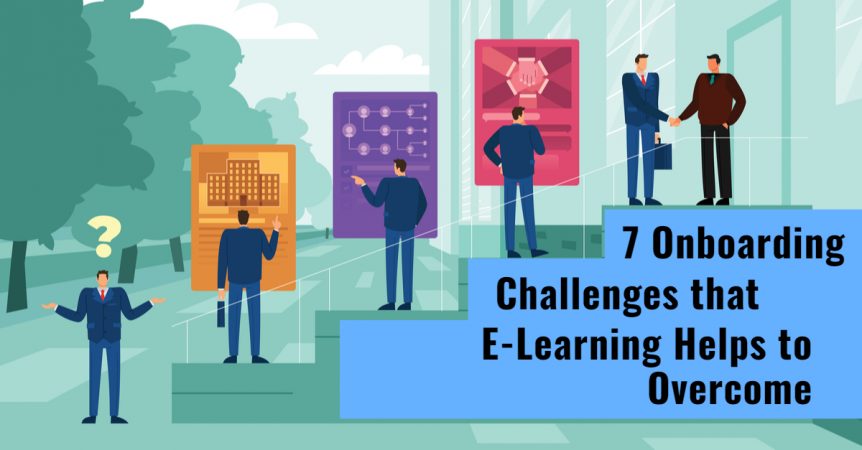7 Onboarding Challenges that E-Learning Helps to Overcome
Staff recruitment and retention are big focus areas for a wide range of companies in the UAE and Saudi Arabia. As a result, the onboarding process is more important than ever, as you don’t want to go through the time, effort, and expense of recruiting new members of the team only to lose them within a short period of time.
E-learning can’t deal with all onboarding challenges, but it will help considerably with the following seven.
Challenge 1 – Poor Quality Information
One of the main objectives of an onboarding process is to provide new hires with the information they will need to do the job and be successful. This includes administrative information, information on processes and systems, and information on performance expectations and how the company operates.
Therefore, it is important to make sure the information that is provided is as high-quality as possible. E-learning helps you achieve this goal.
Challenge 2 – Lack of Consistency in the Onboarding Process
The onboarding experience of new recruits can vary widely. For example, one group of new employees could have a highly engaged manager who makes the process as productive as possible, and who provides all the help the employees need. Another group of new hires, however, could have a manager who is under pressure with other responsibilities, so doesn’t have much time to offer.
E-learning ensures there is consistency across the organisation and at all times, as all new employees will complete the same e-learning content.
Of course, e-learning can’t solve this challenge completely, as onboarding is about more than completing online training courses. However, you can significantly enhance consistency levels with e-learning.
Challenge 3 – Giving Too Much Information Too Quickly
One of the mistakes that organisations make during the onboarding process is giving too much information too quickly. They know there is a lot of information to pass on, and they want to complete the process as fast as possible to get new recruits up to speed with minimal delay.
However, overloading a new employee with too much information too quickly is counterproductive. People have a limited amount of information they can take in at any one time, and the new hires might feel added pressure if they get too much too fast.
By using e-learning, you can provide all the information you need to but in a way that puts the learner in control, i.e., they can complete the training when it best suits them, as the e-learning content will always be at their fingertips.
Challenge 4 – Failing to Provide Adequate Information
The opposite to the above can also happen when onboarding new staff, i.e., failing to give enough information rather than giving too much. Creating a library of e-learning courses and content will resolve this issue, as well as allowing you to refine the content to optimise quality and strike the right balance.
Challenge 5 – Failing to Demonstrate the Company’s Culture
An important objective of an onboarding process is to go through all the necessary procedural issues and information that a new employee will need. You will probably also provide training on processes and anything else that is company specific.
It’s important that onboarding doesn’t stop there, though, as this is the ideal time to give your new hires a good understanding of the company’s culture, including its purpose, values, and objectives. Giving this information helps new employees to begin feeling part of the team, and it can help confirm they have made the right choice by joining your company.
Demonstrating and explaining the company culture through e-learning also introduces new employees to senior leaders, as well as establishing high-level expectations.
Challenge 6 – Insufficient Support with Time Management
Joining a new company can be an overwhelming experience. You meet a lot of new people, there are lots of new things you have to learn, and you are given a lot of new information. At the same time, new employees also want to get going so they can start delivering for their new company.
This presents time management challenges that can lead to increased levels of stress, particularly if the training being provided is on a once-off basis. For example, in-person training.
E-learning gives new hires more autonomy and control over the process, as they will be able to complete various elements of the training when it best suits them. They can also go back over modules whenever they need to, so there isn’t the same pressure to take everything in during a single sitting.
Challenge 7 – Onboarding Processes that Are Boring and Unengaging
While onboarding processes can be informative, interesting and engaging are not terms that are commonly used. Normally, it’s just about getting through the process so you can start doing the job.
You can change this with e-learning, as one of the major benefits of e-learning is that it can be highly successful in engaging learners. You need to create courses and content that are high-quality using professional, instructional design techniques, but e-learning can elevate onboarding in your organisation to another level.
Optimising the Onboarding Process
There are other things that are required to optimise the onboarding process in your company. Addressing the above challenges are a good place to start, as this will provide you with a solid foundation. Plus, with e-learning, you can continuously improve based on feedback and data, updating courses in your library and adding new ones as required.
